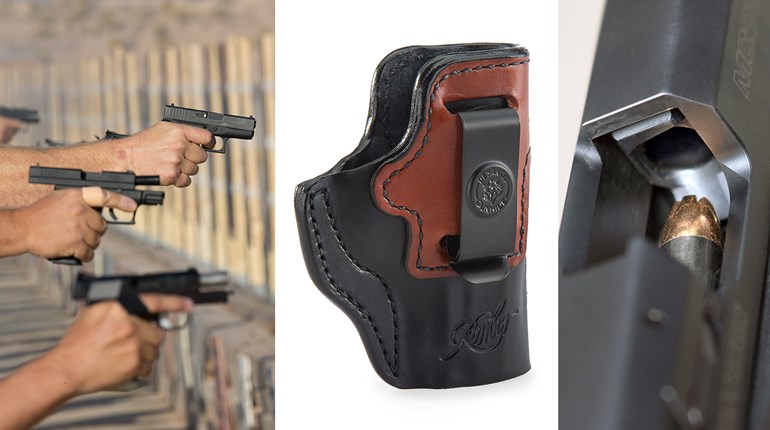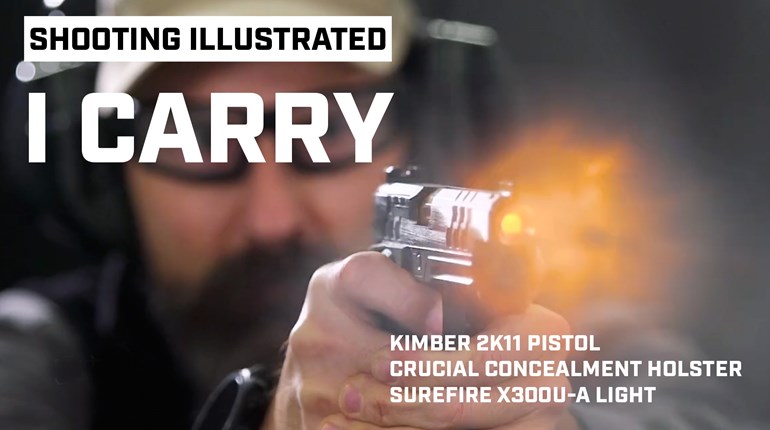
The Kimber K6s revolver is available in eight different models, all in .357 Mag. The model shown above is the company's K6s Stainless variant.
Sometimes life forces us to find compromise. Those of us who choose to carry a firearm for self-defense sometimes stumble over the three words “concealed-carry weapon.” It seems simple enough. “Concealed” implies a small gun that can be easily hidden on your person. “Carry” suggests it should be lightweight so it can be comfortably carried for an extended period of time. “Weapon” denotes a handgun of adequate power to decisively end a life-threatening situation, large enough so it fits your hand and you can accurately place your rounds precisely where needed, and heavy enough that it absorbs some of the recoil generated by an effective defensive handgun cartridge. Something’s gotta give, and the new Kimber K6s .357 Mag. revolver seems to be a good compromise between all of the above.
For the last 150 years or so, Americans have relied on the pocket revolver for discreet armed defense. In the “Roaring Twenties” and through the first half of the 20th century, these snub-nose revolvers were six shooters (kind of an American tradition) and had barrels 2 inches long. Over the last several decades, preferred candidates for this job still sport 2-inch barrels, but have shrunk in size to where the cylinders carry five rounds and the guns weigh around 15 ounces or less. These guns do a marvelous job addressing the “concealed carry” part of the requirement while forcing the armed citizen to work out his or her own compromises on the “weapon” part. Enter the Kimber K6s revolver, a return to an all-steel, six-shot snubbie that weighs 23 ounces and is made to handle full-house .357 Mag. ammo.
You don’t have to lift the Kimber K6s to get a feel for its mass. The barrel has a trapezoidal shape that includes a thick shroud around the ejector rod. The cylinder does not have normal flutes in between chambers, but rather a flattening of the outer-cylinder wall forward of the bolt cuts. Every bit of weight helps when you touch off a .357 Mag. round in a short-barreled revolver. Chambers are recessed in the cylinder, providing a little extra mass in the gun. With the recoil shield slightly smaller in diameter than the cylinder, viewed from the rear, you can see whether or not the gun is loaded without opening the cylinder, or at least you can see into the four partially visible chambers. That’s not the case on all revolvers with recessed chambers.

There’s no external hammer on the Kimber K6s revolver, just the heavy steel frame that slants downward from the rear sight into the backstrap and then runs down to the base of the grip. The trigger guard is an integral part of the frame, with more space in front of the trigger than behind it, and is nicely proportioned with lots of room for the trigger finger. The rear sight is mounted in a large dovetail and smoothly integrated into the frame. It looks like it was part of the original design and not something inserted into the space left vacant for a rear sight to be selected later. The front sight is pinned into a longitudinal slot near the muzzle and is fixed, while the rear sight can be adjusted for windage-only through a single set-screw.
The Kimber K6s .357 Mag. revolver was designed to be shot, not just carried concealed as an insurance package. Sights are big and bold with three large white dots (one front, two rear) that can easily be seen against a dark target. In brighter light against a lighter background, one can clearly see a conventional sight picture and equalize the light intensity on each side of the front-sight blade. I’m not usually a fan of the three-white-dot system, but on the short-barrel Kimber with its three larger dots, this combination works pretty well, at least at close ranges. If it’s too dark to see the sights, it’s probably too dark for you to properly identify your target and determine whether or not there’s a threat. Time for a flashlight.
Everyone who handled the gun liked the double-action-trigger pull. Once the trigger starts to move, its pull weight feels constant throughout the travel distance; and yet, with practice, could be staged just before the trigger broke. For a basic defensive pistol, I think staging is an overrated characteristic for most shooters. It’s the smooth consistency that is most important in a double-action-trigger pull. Still, if you’re shooting at an extended range, say beyond 15 yards, it’s a capability you might put to good use. The trigger has a smooth face with no sharp edges anywhere on it. In fact, the Kimber K6s is the best “dehorned” factory revolver I can remember shooting.
The closest thing to a sharp edge on the gun is the inside of the rear sight and the inside edges in the trough on the topstrap, and I can’t imagine anyone cutting themselves there. The cylinder-release latch was located conventionally on the left side of the Kimber K6s frame and was easy to locate and operate. A push into the frame released the cylinder to swing out for loading and emptying. The latch itself is large and flat with checkering to ensure your thumb does not slip off when pushing. The rear of the latch pivots into the frame and struck me as an improvement compared to the older slide forward or rearward designs that have been around for a century. It’s certainly not a big deal, but a nice feature.

The Kimber K6s revolver I tested had rubber grips with two gently defined finger grooves on the front portion and impressed checkering on the sides. Only two fingers of my shooting hand fit on the frontstrap, but the little finger curled nicely around the base and firmly grasped the side of the grip. The rubber grips were relatively firm compared to others I’ve used, but once a solid shooting grip is achieved with both hands, the package provided adequate comfort and control of the gun when firing the heavier loads. If I relaxed my grip at all, I would have to reposition my hands slightly every couple of shots, but when I did things right, the Kimber was a very comfortable and manageable pocket .357 Mag. The steel backstrap is exposed, allowing those with smaller hands to comfortably reach—and better control—trigger operation, albeit arguably at the expense of recoil mitigation.
Practice your reloads with the Kimber K6s revolver. The ejector-rod stroke is not long enough to push the empty cases (even shorter .38 Spl. brass) all the way out of the chambers. Let gravity work for you. Years ago, in a Clint Smith revolver class at Thunder Ranch, he said that the process of reloading a revolver meant you were either pointing at Jesus or pointing at Satan. Muzzle up to eject empties, muzzle down to load new cartridges. I find that tactical (or partial) reloads are considerably more difficult in a pocket revolver than a larger duty revolver. A speed reload of all chambers is much easier.
I did a lot of head scratching over how to carry the Kimber K6s. For me, small revolvers generally fall into the “pocket carry” category, but with the Kimber’s slightly larger frame size, I didn’t think I could make that work in the pocket of a pair of trousers, at least not consistently. We should strive to carry in the same place whenever possible so we don’t end up searching frantically for our sidearm in a life-or-death scenario.
As always, I looked at belt carry first, specifically holsters carried outside-the-waistband (OWB). I’ve carried small- and medium-frame revolvers in a couple of different Galco rigs and been quite happy. The Kimber is not too heavy, and a loose shirt covers everything fine. However, for strong-side carry I have a distinct preference for a slim semi-auto. There is no lack of respect on my part for the power or function of the K6s, but my many trips to Gunsite (with both semi-automatics and revolvers) have demonstrated the advantages of a semi-auto’s higher-round capacity and faster reloads.
I looked at a couple of ankle holsters for the Kimber K6s revolver, but they’re not my first choice for quick (or subtle) access, generally reserving this type of carry method for deep concealment. Belly band-type rigs are used by numerous folks and work fine if baggy shirts are worn.

The answer came from a local police officer who is a big believer in getting maximum power from a handgun while minimizing self punishment during practice sessions. His thought was that the Kimber stoked with .357 Mag. loads and carried in a soft pocket holster in an outer jacket pocket would be the perfect backup gun or “discreet carry” weapon. In terms of immediate access to the gun while seated, particularly in a car with a seat belt on, the chest pocket is much faster and easier than belt carry.
I don’t usually look forward to range tests with a small, snub-nose .357 Mag., but the Kimber K6s proved to be a pleasant surprise. Velocity readings and group sizes are shown for two .357 Mag. factory loads, one “hot” .38 Spl., and one .38 Spl. designed and rated for small .38 Spl. revolvers. The pleasant surprise was that none of the “hot” loads were painful to shoot and, in fact, proved quite suitable for their intended purpose. Because the sights (and dots) are large, I chose to test at 15 yards rather than the standard 25 yards. As one of the guys at XS Sights once told me, “Big dots are designed for big targets, not small ones.” Large targets become smaller targets as ranges increase, and most self-defense altercations take place at very close ranges.
When attending the new Active Shooter Terrorist Response class at Gunsite, I learned that some of today’s threat scenarios are changing. Mass murderers have different motives and objectives than the old-fashioned robber, rapist, mugger or carjacker. The objective of terrorists is to pile up bodies; there’s no need on their part to make contact with you unless it’s to finish you off. In the Nairobi massacres, and more recently in the softball field attacks in Washington, victims were engaged at extended ranges by an opponent armed with a rifle. This is not the kind of duel in which you’d want to participate, particularly if you’re only equipped with a pocket pistol like the Kimber K6s revolver.
However, in video from the Nairobi shopping center, the attackers showed a reluctance to advance when confronting return fire. They may have been ready to die, but they were in no hurry to do so. As in any gunfight, if you can make them break off the attack, even for a few minutes, it will give you a chance to escape. Your objective is to survive until professional help arrives. While we generally don’t walk about with a slung rifle for self protection, there is an advantage (besides the extra round) in carrying a powerful pocket pistol like the Kimber K6s. If you can make a hit anywhere on your assailant, there is a greater likelihood of incapacitation, giving you a better opportunity for you and your loved ones to get away.
Even as I write this, multiple variants on the Kimber K6s .357 Mag. revolver, including one with a 3-inch barrel and various grips, are being produced Grip options are always good in terms of finding the best fit for your hand. And if your carry plans will accommodate an extra inch of barrel length, you might want to check out what an extra inch of sight radius does for your ability to protect yourself and your family. I haven’t met the rest of the Kimber K6s family, but based upon my work with the patriarch, I’d say it looks like an excellent gene pool.








































